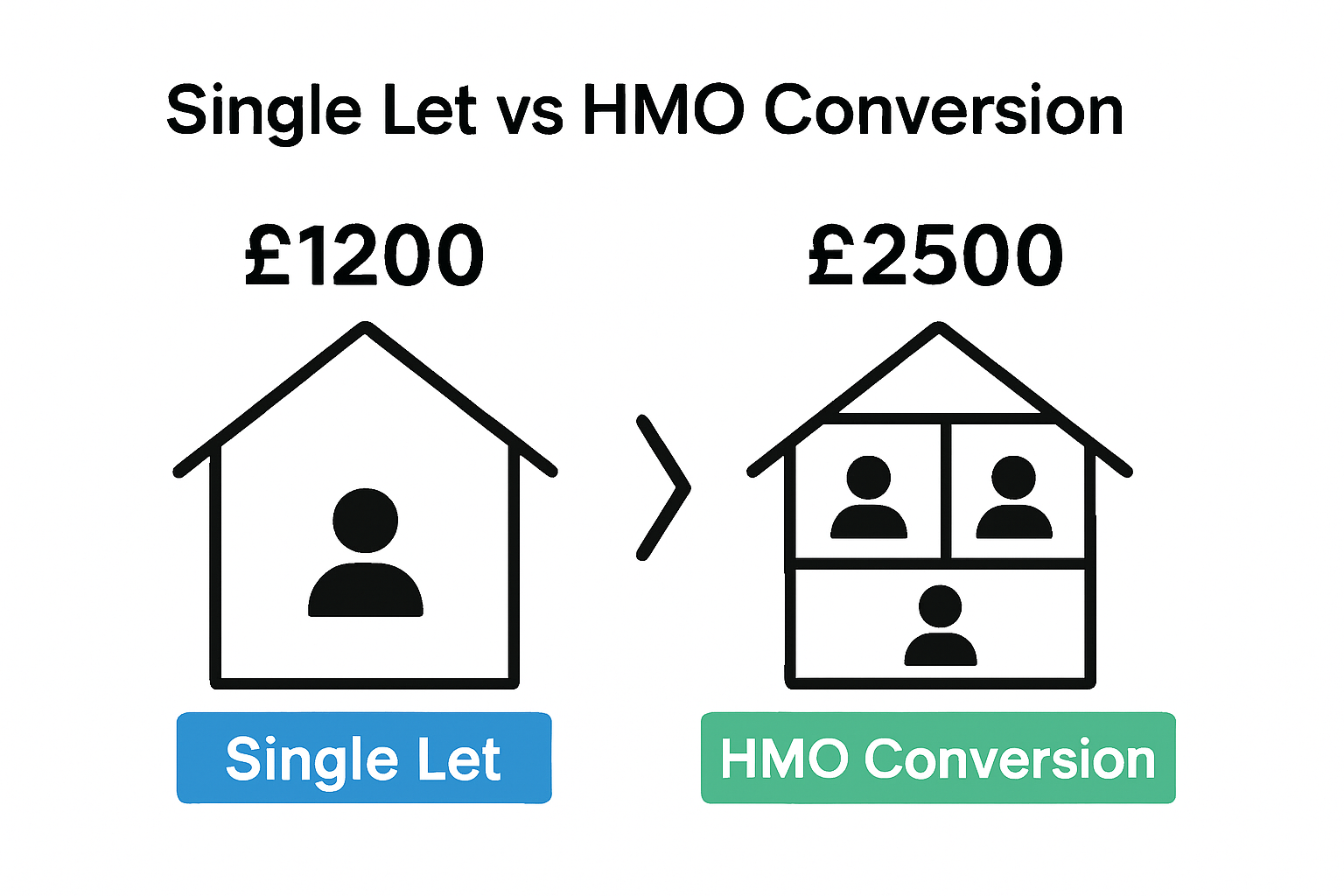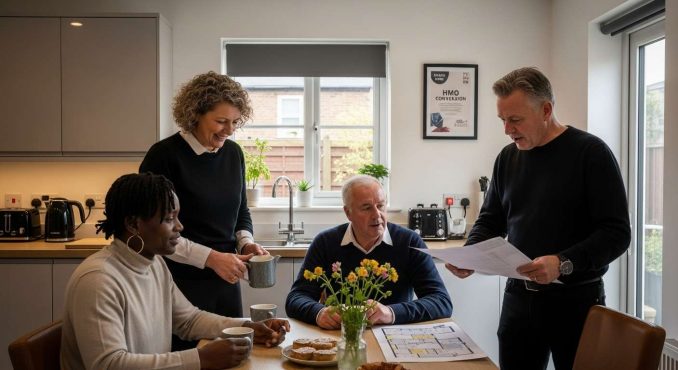Turning a regular house into a rental goldmine might sound like a property owner’s dream. In fact, HMO conversions can generate up to three times the rental income of a standard single-let property. Most would think that squeezing in more tenants just means extra hassle and paperwork. The surprise is this strategy is actually built on strict rules and clever design that not only backs your investment but also keeps everyone safer and happier than you might expect.
Quick Summary
| Takeaway | Explanation |
|---|---|
| HMO conversion increases rental income potential | Property owners can earn 2-3 times higher rent compared to single-tenancy models, enhancing profitability. |
| Regulatory compliance is crucial | Navigating planning permissions and safety regulations ensures legal operation, avoiding costly fines or complications. |
| Assess property before conversion | Evaluate structural integrity and market demand to determine suitability for multi-tenant occupancy effectively. |
| Implement strategic design modifications | Create distinct living areas and upgrade amenities to meet safety standards, enhancing tenant experience and property value. |
| Develop robust tenant management protocols | Establish clear agreements and screening processes to ensure a stable and compliant tenancy, reducing vacancy risks. |
Defining HMO Conversion: What It Means
HMO conversion represents a critical property transformation process that enables property owners to maximize their investment potential by reconfiguring residential spaces to accommodate multiple independent tenants. Understanding what HMO conversion entails requires a comprehensive examination of its fundamental principles and strategic implications.
The Core Concept of HMO Conversion
At its essence, HMO conversion involves systematically modifying a single residential property to legally accommodate multiple unrelated tenants who will share common living spaces. According to government housing regulations, an HMO is defined as a property occupied by at least three tenants from different households, sharing essential facilities like kitchens and bathrooms.
Key characteristics of HMO conversion include:
- Structural modifications to create additional living spaces
- Installation of separate bedroom configurations
- Upgrading shared amenities to meet safety and regulatory standards
- Ensuring compliance with local housing authority requirements
Property owners undertake HMO conversion with multiple motivations, including:
- Generating higher rental income compared to traditional single-tenancy models
- Maximising property utilisation in high-demand urban areas
- Creating flexible living arrangements for diverse tenant demographics
Regulatory Considerations in HMO Conversion
Successful HMO conversion demands meticulous attention to legal and safety frameworks. Owners must navigate complex regulatory landscapes involving planning permissions, building regulations, fire safety standards, and licensing requirements. Property investment research indicates that comprehensive understanding of these regulations is paramount to avoiding potential legal complications.
Professional investors often collaborate with architectural specialists and local planning authorities to ensure their HMO conversion projects meet all necessary statutory requirements. This strategic approach minimises risks and maximises the property’s potential for sustainable, compliant multi-tenant occupancy.

While HMO conversion presents significant opportunities, it is not a one-size-fits-all strategy. Careful evaluation of property characteristics, local market dynamics, and potential tenant demographics remains crucial for successful implementation. Learn more about HMO property opportunities to understand how these conversions can transform residential investment strategies.
The Importance of HMO Conversions in Property Investment
HMO conversions have emerged as a transformative strategy within property investment, offering sophisticated investors a nuanced approach to maximising property portfolio performance and generating substantial rental yields. Understanding the strategic significance of these conversions requires deep insight into their multifaceted economic and operational advantages.
Financial Performance and Revenue Generation
Property investors recognise HMO conversions as a powerful mechanism for enhancing financial returns. According to UK property investment analysis, HMO properties consistently generate significantly higher rental incomes compared to traditional single-tenancy residential investments.

Key financial advantages include:
- Potential to generate 2-3 times higher rental income per property
- Reduced vacancy risk through multiple tenant streams
- Enhanced portfolio diversification and income stability
- Improved cash flow management through distributed rental payments
Risk Mitigation and Market Adaptability
Successful property investment demands strategic risk management. HMO conversions provide investors with robust mechanisms to mitigate financial vulnerabilities. By distributing tenancy across multiple occupants, investors create a more resilient income model that can withstand individual tenant departures or economic fluctuations.
Risk reduction strategies encompass:
- Spreading income potential across multiple tenant segments
- Creating more flexible property utilisation models
- Developing adaptable living spaces for changing demographic needs
- Implementing comprehensive tenant screening processes
Strategic Property Value Enhancement
Beyond immediate rental returns, HMO conversions represent a sophisticated long-term property value enhancement strategy. Professional investors view these conversions as opportunities to significantly increase property market valuation through strategic improvements and expanded functional capacity.
The comprehensive approach to HMO conversion involves careful property selection, intelligent design modifications, and compliance with regulatory frameworks. Learn more about HMO property investment strategies to understand how these sophisticated investment approaches can transform residential real estate portfolios.
While HMO conversions offer substantial opportunities, successful implementation requires meticulous planning, deep market understanding, and a commitment to maintaining high-quality living environments for diverse tenant populations.
How HMO Conversions Work: The Process Explained
HMO conversion is a sophisticated property transformation strategy that requires systematic planning, precise execution, and comprehensive understanding of regulatory frameworks. The process involves intricate steps designed to convert traditional residential properties into multi-occupancy living spaces that maximise investment potential and tenant functionality.
Initial Property Assessment and Feasibility
Successful HMO conversion begins with a rigorous property evaluation. According to property development research, investors must conduct comprehensive assessments to determine a property’s suitability for multi-tenant occupation.
Critical evaluation criteria include:
- Structural integrity and potential modification capacity
- Location and proximity to amenities
- Local housing market demand
- Potential return on investment
- Compliance with local planning regulations
Architectural and Regulatory Modifications
Once a property passes initial assessment, the conversion process involves detailed architectural redesign and regulatory compliance. Property owners must strategically reconfigure living spaces to create distinct, functional living areas while ensuring adherence to safety standards and local housing regulations.
Key modification considerations encompass:
- Creating separate bedroom configurations
- Installing additional bathroom facilities
- Upgrading electrical and fire safety systems
- Ensuring adequate kitchen and communal spaces
- Implementing sound insulation and privacy measures
Licensing and Operational Preparation
The final stage of HMO conversion involves obtaining necessary licensing and preparing the property for multi-tenant occupation. This phase requires meticulous documentation, compliance verification, and strategic operational planning to ensure sustainable, legally compliant rental management.
Operational preparation involves:
- Obtaining mandatory HMO licensing from local authorities
- Developing comprehensive tenant management protocols
- Establishing maintenance and repair frameworks
- Creating clear tenancy agreements
- Implementing robust tenant screening processes
Explore comprehensive HMO property investment opportunities to understand the nuanced strategies behind successful property conversions. While the process demands significant investment and expertise, HMO conversions represent a powerful approach to maximising property portfolio performance and generating substantial rental yields.
Key Concepts and Regulations in HMO Conversion
HMO conversion navigates a complex landscape of legal frameworks, safety regulations, and operational standards that demand comprehensive understanding and meticulous compliance. The intricate regulatory environment surrounding these property transformations requires investors to develop nuanced strategies that balance financial objectives with statutory requirements.
Defining Regulatory Parameters
According to the UK Housing Act 2004, HMO properties are subject to specific legal definitions and licensing requirements that distinguish them from traditional residential accommodations. These regulations establish fundamental parameters for multi-occupancy living spaces, ensuring tenant safety and maintaining minimum property standards.
Key regulatory concepts include:
- Precise definitions of multi-occupancy living arrangements
- Mandatory licensing thresholds for HMO properties
- Minimum room size and occupancy standards
- Comprehensive safety infrastructure requirements
- Tenant protection mechanisms
Safety and Compliance Frameworks
Safety represents a paramount consideration in HMO conversion, with stringent regulations governing every aspect of property design and management. Fire safety research indicates that HMO properties require sophisticated safety infrastructure significantly beyond standard residential expectations.
Critical safety compliance elements encompass:
- Mandatory fire detection and suppression systems
- Enhanced electrical safety certification
- Comprehensive emergency evacuation protocols
- Regular property condition assessments
- Detailed maintenance and risk management documentation
Licensing and Administrative Requirements
Successful HMO conversion demands rigorous administrative processes and ongoing regulatory engagement. Property owners must navigate complex licensing frameworks that require continuous compliance monitoring and proactive management approaches.
Administrative obligations typically involve:
- Obtaining mandatory local authority HMO licenses
- Submitting detailed property management documentation
- Implementing robust tenant screening processes
- Maintaining comprehensive property records
- Ensuring continuous regulatory compliance
Explore detailed HMO property investment guidance to understand the intricate regulatory landscape surrounding these sophisticated property investments. Professional investors recognise that successful HMO conversion transcends mere property modification, representing a strategic approach to creating compliant, high-performing residential assets.
Below is a table summarising the essential regulatory concepts and safety requirements governing HMO conversions, providing a clear comparison of their key features and purposes.
| Regulatory Concept | Key Features | Main Purpose |
|---|---|---|
| Legal Definition (Housing Act 2004) | Defines multi-occupancy arrangements, minimum room sizes, and required facilities | Sets statutory foundation for HMOs |
| Mandatory HMO Licensing | Requires local authority licensing for qualifying properties | Ensures oversight and regulatory compliance |
| Minimum Occupancy Standards | Specifies maximum tenant numbers and minimum room measurements | Maintains comfort and prevents overcrowding |
| Fire Safety Regulations | Demands fire detection, suppression systems, and emergency exit protocols | Protects occupants from fire risk |
| Electrical Safety Certification | Compulsory periodic inspection and certification of electrical installations | Safeguards electrical safety |
| Tenant Protections | Mandates clear agreements and formal tenant management protocols | Ensures tenant rights and transparency |
| Maintenance and Risk Record-keeping | Requires comprehensive records of property checks, repairs, and risk assessments | Facilitates proactive safety management |
Ready to Take the Next Step with Your HMO Conversion?
Turning a traditional property into a compliant, income-generating HMO can feel overwhelming. The article highlights challenges such as navigating complex regulations, ensuring safety standards, and maximising returns on your investment. If you are questioning whether your HMO project ticks all the legal boxes or you feel uncertain about the next move, you are not alone. The process can be daunting, especially when juggling architectural design, licensing, and tenant management needs all at once.
AgentHMO brings clarity to the HMO conversion process. Our platform connects you with trusted HMO property services, including experienced estate agents, property managers, and regulatory experts. Whether you want to explore current HMO investment opportunities or seek tailored guidance on compliance, you will find reliable support and up-to-date resources right here. Empower your next HMO project with confidence and join a thriving network of investors and service providers. Start your journey by visiting AgentHMO today and claim your place in the UK’s fast-moving HMO market.
Frequently Asked Questions
What is HMO conversion?
HMO conversion refers to the process of modifying a single residential property to accommodate multiple unrelated tenants who share common living spaces, such as kitchens and bathrooms.
What are the key benefits of HMO conversion for property owners?
The main benefits include generating higher rental income, maximising property utilisation, and creating flexible living arrangements to cater to diverse tenant demographics.
What regulatory considerations should property owners be aware of during HMO conversion?
Property owners must adhere to local housing authority requirements, including planning permissions, building regulations, fire safety standards, and obtaining necessary licensing for multi-tenant occupancy.
How does the HMO conversion process begin?
The HMO conversion process starts with an initial property assessment, evaluating factors such as structural integrity, location demand, and compliance with local regulations to determine suitability for multi-tenant occupation.


